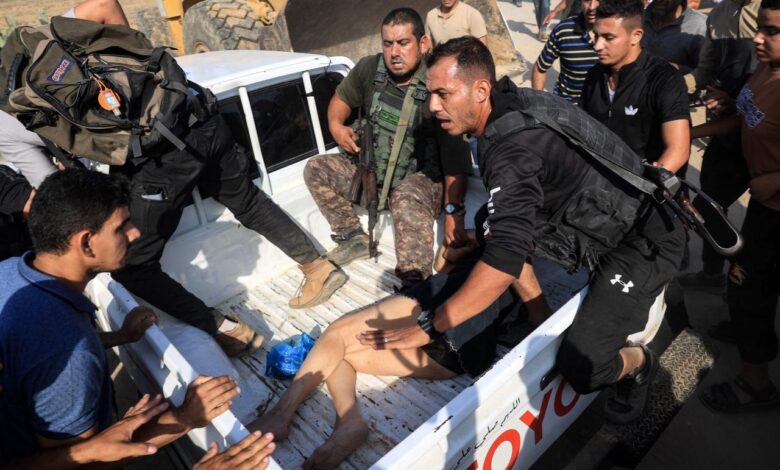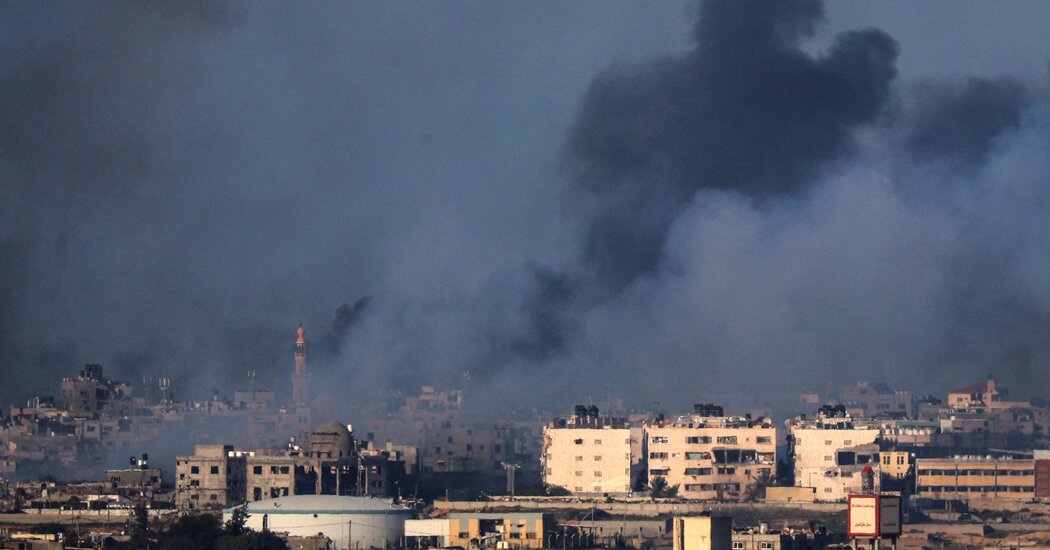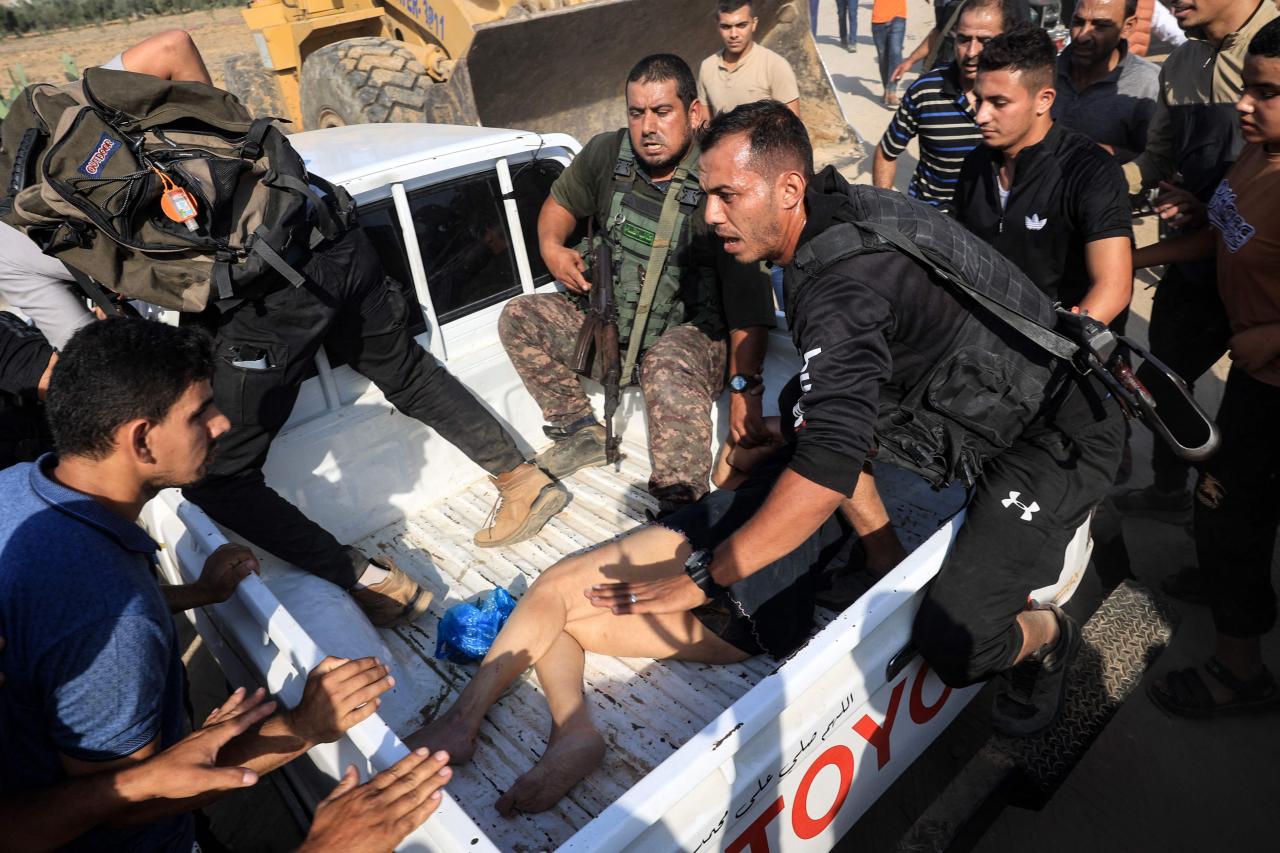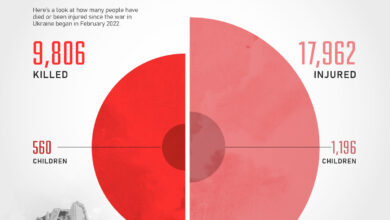
Israel Hamas Gaza News A Deep Dive
Israel Hamas Gaza news is dominating headlines, and the situation is incredibly complex. This deep dive explores the historical context, current events, humanitarian crisis, international response, underlying issues, potential outcomes, and the broader implications of this escalating conflict. We’ll analyze the perspectives of Israelis, Palestinians, and the international community, looking at the roots of the conflict and the challenges in finding a resolution.
From the historical roots of the conflict to the immediate triggers of the recent escalation, this comprehensive overview will equip readers with a better understanding of the complexities of this ongoing crisis. We’ll delve into the humanitarian impact on Gaza, explore the diverse international responses, and analyze the underlying political, economic, and social factors that fuel the conflict. Finally, we’ll consider possible future scenarios and the potential long-term consequences of the events unfolding.
Historical Context
The Israeli-Palestinian conflict is one of the most enduring and complex geopolitical disputes in the world. Rooted in historical claims and competing national aspirations, it has evolved through decades of violence, peace initiatives, and ongoing tensions. Understanding the historical context is crucial to comprehending the current crisis and the deeply entrenched positions of both sides.The conflict’s origins are deeply intertwined with the historical presence of both Jewish and Arab communities in the region.
The Balfour Declaration of 1917, promising a Jewish homeland in Palestine, set the stage for future conflicts, as it was perceived by the Arab population as a betrayal of their own aspirations for self-determination.
Key Events Leading to the Current Situation
The creation of Israel in 1948, following the end of the British Mandate, sparked the first Arab-Israeli war. This event resulted in displacement and conflict, shaping the demographics of the region and solidifying the conflict’s core issues. Subsequent wars, such as the Six-Day War in 1967 and the Yom Kippur War in 1973, further defined the borders and power dynamics, with Israel gaining control of territories including the West Bank and Gaza Strip.
The occupation of these territories continues to be a significant point of contention.
Evolution of Key Players and Their Positions
The conflict involves multiple parties, each with distinct historical relationships and positions. Israel, founded on the idea of a Jewish homeland, has maintained a focus on security and its right to exist within secure borders. The Palestinian side, advocating for a Palestinian state, has emphasized self-determination and the right of return for Palestinian refugees. The involvement of other regional and international actors, such as the United States and other nations, has further complicated the situation.
Major Treaties, Agreements, and Peace Initiatives
Numerous attempts at peace have been made throughout the decades. The Oslo Accords, signed in the 1990s, were a significant step toward a two-state solution, though they ultimately failed to achieve a lasting peace. Other peace initiatives, including the Camp David Accords, have yielded some progress but have not resolved the underlying issues. The persistent lack of a comprehensive and mutually acceptable agreement has left the conflict unresolved.
Differing Perspectives on the Conflict
| Perspective | Key Points |
|---|---|
| Israeli | Security concerns are paramount. Israel asserts a right to exist within secure borders and emphasizes the historical connection to the land. |
| Palestinian | The right to self-determination and a sovereign Palestinian state is a central demand. Palestinians emphasize the need for the right of return for refugees and an end to the Israeli occupation. |
| International | The international community generally supports a two-state solution, calling for an end to violence and the establishment of a Palestinian state alongside Israel. However, there’s no consensus on the specific terms of the solution. |
Current Events Overview
The recent escalation of hostilities between Israel and Hamas in Gaza has resulted in a devastating humanitarian crisis. The conflict, marked by intense violence and civilian casualties, has drawn global attention and condemnation. Understanding the current state of the conflict, the key actors, and the immediate triggers is crucial for comprehending the complex dynamics at play.
Current State of Hostilities
The recent conflict began on [Insert Date] and continues to unfold. Key actors involved include the Israeli Defense Forces (IDF), Hamas, and various Palestinian factions. Major incidents have occurred in several locations throughout Gaza, with the most significant battles occurring in [Insert Specific Locations]. The nature of the fighting includes air strikes, missile attacks, and ground operations.
The intensity and scale of the conflict highlight the urgent need for a peaceful resolution.
Immediate Causes and Triggers
The immediate triggers for the escalation remain a subject of debate and differing accounts. Some reports suggest that the escalation stemmed from a series of escalating tensions, including [Insert Specific Triggers, e.g., border clashes, alleged violations of Palestinian rights]. Others point to specific events, such as [Insert Specific Events]. The interplay of these factors has created a volatile environment, rapidly escalating into the current conflict.
Differing Accounts and Narratives
Different parties involved present contrasting accounts of the events. Israel’s narrative emphasizes [Insert Israeli Narrative Points]. Conversely, Hamas and other Palestinian factions assert [Insert Hamas/Palestinian Narrative Points]. These differing narratives reflect the deep-seated political and historical grievances contributing to the conflict. It is important to approach these accounts with a critical eye, acknowledging the inherent biases that may influence each perspective.
Geographic Locations and Impact
| Geographic Location | Impact |
|---|---|
| Gaza Strip | The Gaza Strip has borne the brunt of the fighting, with widespread destruction of infrastructure, homes, and vital services. Civilian casualties have been substantial. |
| Southern Israel | Southern Israel has been subjected to rocket fire from Gaza, causing displacement and concern for residents. |
| International Community | The conflict has placed significant strain on international relations, and there are significant humanitarian concerns regarding the impact on the region’s stability. |
The table above illustrates the varying geographic impacts of the conflict. The geographic spread of the violence highlights the humanitarian crisis and the far-reaching consequences of the current hostilities.
Humanitarian Crisis in Gaza
The ongoing conflict has unleashed a devastating humanitarian crisis in Gaza, leaving a trail of suffering and destruction in its wake. The relentless bombardment and subsequent blockade have severely impacted the civilian population, creating a dire situation with escalating needs. The crisis necessitates immediate and comprehensive international aid efforts to address the overwhelming challenges faced by the people of Gaza.The relentless shelling and fighting have caused widespread destruction of homes, infrastructure, and essential services.
This has led to a catastrophic shortage of basic necessities, exacerbating the already precarious living conditions in the densely populated region. The impact on healthcare, water, and shelter is particularly severe, creating a humanitarian emergency that demands immediate attention.
Impact on Essential Services
The conflict has crippled essential services in Gaza, leaving the civilian population vulnerable and exposed to immense suffering. Healthcare facilities are severely damaged or overwhelmed, leading to a critical shortage of medical supplies, equipment, and personnel. Water scarcity is another major concern, with damaged infrastructure and disrupted access to clean water sources. Damaged homes and shelters leave countless people without adequate housing, creating immense challenges for vulnerable populations.
Healthcare Challenges
Hospitals and clinics in Gaza are facing immense pressure, struggling to cope with the influx of casualties and the overwhelming demand for medical attention. The shortage of essential medical supplies, equipment, and qualified personnel is particularly acute, making it difficult to provide adequate healthcare services to the injured and sick. Many facilities have been damaged or destroyed, further compounding the problem.
The ongoing conflict disrupts the provision of routine medical care, leading to a rise in preventable illnesses and further deterioration of public health.
Water and Sanitation Crisis
The conflict has significantly disrupted water and sanitation services in Gaza. Damage to water infrastructure, including pipelines and treatment plants, has led to severe water shortages, impacting the health and well-being of the population. The lack of clean water and sanitation facilities has created a breeding ground for disease outbreaks, putting additional strain on the already overwhelmed healthcare system.
This situation further compounds the humanitarian crisis, creating a dire public health concern.
Shelter and Housing Needs
The conflict has caused widespread destruction of homes and shelters in Gaza, leaving thousands of people homeless and displaced. The destruction has impacted the most vulnerable members of society, including women, children, and the elderly, who are disproportionately affected by the lack of adequate housing and shelter. This has created a desperate need for temporary and permanent housing solutions, in addition to the immediate needs for food and medical supplies.
International Aid Efforts
Various international organizations and aid groups have responded to the crisis, providing critical humanitarian assistance to the affected communities in Gaza. These efforts are essential in addressing the immediate needs of the people, but significant gaps remain in the provision of comprehensive aid. The coordination of these efforts is crucial for ensuring that assistance reaches those who need it most.
Distribution of Aid and Resources (Illustrative Example)
| Affected Community | Type of Aid Provided | Quantity |
|---|---|---|
| UNRWA Camps | Food, Water, Shelter Materials | 10,000 families |
| Urban Areas | Medical Supplies, Hygiene Kits | 50,000 individuals |
| Rural Communities | Agricultural Support, Seeds | 200 farms |
| Displaced Persons | Temporary Shelters, Food | 15,000 people |
Note: This table provides an illustrative example and does not represent the exact distribution of aid. Real-world data would require a much more detailed analysis from verified sources.
International Response

The conflict between Israel and Hamas in Gaza has triggered a significant international response, encompassing diverse reactions, diplomatic efforts, and varying stances from world leaders. Countries and organizations have grappled with navigating the complex geopolitical landscape, balancing humanitarian concerns with national interests. This section explores the multifaceted international response, highlighting the different approaches and positions adopted.
Reactions of Countries and International Organizations
The international community’s response to the conflict has been marked by a mix of condemnation, calls for de-escalation, and humanitarian aid initiatives. Many countries have issued statements condemning the violence and expressing concern for the safety of civilians. The UN, through various agencies, has been actively engaged in providing aid and coordinating humanitarian efforts. European nations, in particular, have voiced strong calls for a ceasefire and emphasized the need to protect civilians.
Diplomatic Efforts
Several diplomatic initiatives have been undertaken to mediate the conflict. These efforts, however, have faced significant challenges due to the deeply entrenched positions of both sides. Mediation attempts by international actors have been hampered by the lack of direct engagement from Hamas and the ongoing military operations. While some countries have been actively involved in facilitating dialogue, significant progress has yet to be achieved.
Positions of World Leaders
World leaders have expressed varying positions on the conflict, reflecting the diverse perspectives and priorities of their nations. Some have emphasized the need for a swift ceasefire, while others have focused on holding Hamas accountable for its actions. Statements by leaders often highlight the need for accountability and a return to peace talks, but the specifics of their approaches and their relative influence on the conflict remain highly variable.
Table of International Actor Stances
| International Actor | Stance | Actions |
|---|---|---|
| United States | Condemning Hamas attacks, supporting Israel’s right to self-defense, urging de-escalation. | Providing military aid to Israel, issuing statements condemning Hamas. |
| United Nations | Expressing concern for the humanitarian crisis, delivering aid to Gaza, calling for a ceasefire. | Deploying humanitarian assistance teams, coordinating aid distribution, issuing resolutions. |
| European Union | Condemning the violence, calling for an immediate ceasefire, advocating for a two-state solution. | Issuing statements, imposing sanctions on Hamas (in some cases), providing humanitarian assistance. |
| Arab League | Condemning the violence, emphasizing the need for a ceasefire, advocating for a resolution based on international law. | Issuing statements, coordinating efforts with other international actors, calling for protection of civilians. |
| Russia | Taking a neutral stance, calling for a cessation of hostilities, focusing on humanitarian concerns. | Issuing statements, potentially mediating behind the scenes (unconfirmed). |
Analysis of Underlying Issues
The ongoing conflict between Israel and Hamas, particularly the recent escalation in Gaza, is deeply rooted in a complex interplay of political, economic, and social factors. Understanding these underlying issues is crucial to comprehending the conflict’s gravity and potential for lasting resolution. Territorial disputes, water scarcity, and deeply entrenched political settlements all contribute to the volatile atmosphere. Furthermore, the historical and present-day tensions surrounding religious sites and cultural heritage add another layer of complexity.The Israeli-Palestinian conflict is a multifaceted struggle with historical roots stretching back decades.
The conflict’s intensity is fueled by competing claims to land, resources, and political control. These competing narratives are deeply intertwined with cultural and religious identities, making a peaceful resolution even more challenging.
Key Political Issues
The Israeli-Palestinian conflict is fundamentally a political dispute over land and self-determination. The 1948 Arab-Israeli War, the 1967 Six-Day War, and subsequent occupation of Palestinian territories have created a legacy of mistrust and animosity. Ongoing political negotiations and disagreements over borders, settlements, and the status of Jerusalem have failed to resolve these deep-seated issues. The lack of a two-state solution further exacerbates the conflict.
Different interpretations of historical events and competing claims to the same land continue to drive the cycle of violence.
Economic Factors
The Palestinian economy has been significantly impacted by the conflict. The blockade of Gaza, Israeli occupation of Palestinian territories, and limited economic opportunities have created severe economic hardship for Palestinians. These economic constraints contribute to a sense of desperation and frustration, making individuals more susceptible to extremist ideologies. Limited access to resources and markets restricts economic growth, impacting livelihoods and exacerbating the humanitarian crisis.
Social and Cultural Tensions
The historical and cultural significance of religious sites, such as the Western Wall and the Temple Mount, has been a major point of contention. The control and access to these sacred sites are deeply embedded in the identity of both Israelis and Palestinians. The conflict has also resulted in a loss of cultural heritage and a division within Palestinian communities.
Territorial Disputes and Water Resources
The control of land and water resources is another key factor contributing to the conflict. The limited water resources in the region, exacerbated by historical and political disputes, have intensified the tension. Israel’s control over water resources in the West Bank and Gaza Strip is a source of contention. The lack of equitable access to water resources for both Israelis and Palestinians fuels resentment and creates a cycle of hardship.
Political Settlements
Israeli settlements in the occupied Palestinian territories are a major source of friction. These settlements are viewed by Palestinians as a violation of their rights and a barrier to achieving a two-state solution. The presence of settlements undermines the possibility of a contiguous and viable Palestinian state. This issue fuels the conflict and complicates any efforts to achieve lasting peace.
Comparison of Israeli and Palestinian Perspectives
| Issue | Israeli Perspective | Palestinian Perspective |
|---|---|---|
| Territorial Disputes | Israel views its borders as historically justified and necessary for security. | Palestinians assert their right to self-determination and a sovereign state within their historical boundaries. |
| Water Resources | Israel emphasizes the need for water resources for its population and argues for equitable management. | Palestinians claim that Israel’s control over water resources disproportionately impacts their access and livelihoods. |
| Political Settlements | Israel views settlements as a security measure and an expression of its historical connection to the land. | Palestinians consider settlements as a violation of international law and an obstacle to a two-state solution. |
| Religious Sites | Israel considers religious sites as integral to its cultural and historical heritage. | Palestinians view religious sites as vital to their religious identity and cultural heritage. |
Potential Outcomes and Future Implications
The escalating conflict between Israel and Hamas, particularly the devastating events in Gaza, presents a complex web of potential outcomes. The immediate humanitarian crisis demands urgent attention, while the long-term ramifications for the region and the global community are significant and uncertain. Understanding these potential scenarios is crucial for anticipating the future and crafting effective responses.The conflict’s trajectory is unpredictable, influenced by a multitude of factors, including the actions of all parties involved, the international community’s response, and the underlying tensions that fuel the conflict.
A swift resolution is unlikely, and the potential for protracted instability remains high.
Potential Scenarios for Resolution
The possibility of a ceasefire, brokered by international mediators, is a key factor in shaping the future. However, the terms of any ceasefire agreement and the subsequent implementation remain uncertain. The potential for a temporary cessation of hostilities, followed by a more enduring peace process, is a realistic, yet not guaranteed, outcome.
Potential Scenarios for Continuation of the Conflict, Israel hamas gaza news
The current conflict could escalate further, with intensified fighting on both sides. The potential for regional involvement and a broader conflict remains a significant concern. The existing grievances and underlying issues, if not addressed, could lead to a cycle of violence, hindering any prospect of lasting peace. The conflict’s continuation could also lead to further displacement of civilians and a worsening humanitarian crisis.
Long-Term Consequences of the Current Events
The long-term consequences of the current conflict are multifaceted. The devastating damage to Gaza’s infrastructure, including hospitals and homes, will have lasting effects on the lives of Palestinians. The economic impact on both Israel and the Palestinian territories is also substantial. The deep-seated distrust and hostility between the parties could also impede any future peace negotiations.
Regional and Global Implications
The conflict’s regional implications are significant. The potential for further instability in the Middle East is a major concern, affecting neighboring countries and regional security. Globally, the conflict highlights the ongoing challenges in achieving lasting peace and resolving complex geopolitical issues. The conflict’s global impact could be felt in terms of humanitarian aid requirements and potential economic repercussions.
Potential Solutions to Underlying Causes of the Conflict
Addressing the root causes of the conflict is essential for achieving lasting peace. These include issues such as the Israeli-Palestinian territorial dispute, the need for Palestinian self-determination, and the ongoing humanitarian concerns. A comprehensive approach, encompassing economic development, security measures, and political reforms, is necessary. International efforts are needed to facilitate dialogue and build trust between both sides.
Possible Peace Processes
A viable peace process would involve significant steps, including the establishment of a Palestinian state alongside Israel. This could involve negotiations on borders, security arrangements, and the status of Jerusalem. The process must also address the issue of Palestinian refugees and ensure their right of return. The inclusion of international mediators and the establishment of mechanisms for monitoring and verification are essential components of a credible and effective peace process.
Existing models of conflict resolution could provide valuable lessons and frameworks for developing future peace processes. International support and the commitment of both sides to a peaceful resolution are crucial.
Illustrative Images and Visual Aids: Israel Hamas Gaza News
This section delves into the crucial role of visual aids in conveying the human cost and geographical impact of the conflict. Images and maps, while not replacing the nuanced reporting of events, offer powerful tools to understand the multifaceted crisis. They provide a glimpse into the lived experiences of those affected and offer a spatial context for the conflict’s reach.
Impact on a Specific Community
A powerful image depicting the impact on a specific community could show a family huddled together in a bombed-out home. The faces of the individuals, particularly the children, would reflect the fear and trauma. The rubble and debris surrounding them would underscore the physical destruction. This image would evoke a visceral response, highlighting the human cost of the conflict, not just the statistics.
The image’s effectiveness would lie in its ability to connect the viewer with the lived experience of those affected. The photograph might also show the scarcity of resources, such as food or water, further emphasizing the humanitarian crisis.
Geographical Impact of the Conflict
A detailed map illustrating the conflict’s geographical impact would overlay the regions affected by the fighting, clearly marking areas of intense bombardment. Different colors could be used to differentiate areas of intense conflict, moderate conflict, and areas untouched by direct fighting. The map would be overlaid with key locations, such as settlements, hospitals, and supply routes. Such a visual representation would effectively illustrate the geographical scope of the conflict, demonstrating the areas most severely affected.
It would also highlight the potential risks to humanitarian aid access and the criticality of these supply routes.
Visual Representation of Humanitarian Needs in Gaza
A visual representation of the humanitarian needs in Gaza could take the form of a series of interconnected infographics. One graphic could illustrate the breakdown of essential resources like food, water, and medical supplies. Another graphic could depict the significant number of displaced individuals and their urgent need for shelter and assistance. This visualization could also include the number of children affected, the number of healthcare facilities damaged or destroyed, and the significant strain on existing infrastructure.
These interconnected infographics would present a comprehensive overview of the critical needs and their severity.
Visual Representation of the International Response
A visual representation of the international response could include a series of images showing various humanitarian aid organizations providing assistance. These could include images of aid workers distributing food, medical supplies, or water, and images of international aid convoys entering Gaza. Images of international diplomats or government officials could also be included, highlighting the efforts of the international community to respond to the crisis.
This visual representation could include a timeline showing the various stages of the response and the international organizations involved. This approach would effectively demonstrate the extent and nature of the international community’s involvement.
Content Structuring

This section details the structured approach to presenting information about the Israel-Hamas-Gaza conflict. The format prioritizes clarity, conciseness, and ease of navigation, using subheadings and bullet points to break down complex issues into digestible chunks. A table of contents will allow readers to quickly access specific areas of interest. This method aims to provide a comprehensive yet accessible overview of the multifaceted conflict.
Table of Contents
- Historical Context: A concise overview of the historical tensions between Israel, Hamas, and the Palestinian people, providing context for the current conflict.
- Current Events Overview: A chronological account of significant events leading up to and during the current escalation.
- Humanitarian Crisis in Gaza: A detailed examination of the human cost of the conflict, focusing on the urgent needs and challenges faced by civilians.
- International Response: An analysis of the various international reactions and diplomatic efforts to address the crisis.
- Analysis of Underlying Issues: An exploration of the deeper political, social, and economic factors contributing to the conflict.
- Potential Outcomes and Future Implications: A consideration of potential scenarios and their likely impact on the region and global community.
Historical Context
The Israeli-Palestinian conflict has deep roots, spanning decades of political and territorial disputes. Understanding the historical context is crucial to comprehending the current crisis. Key events include the 1948 Arab-Israeli War, the 1967 Six-Day War, and the subsequent occupation of Palestinian territories. These events, along with the ongoing conflict over land, borders, and settlements, have shaped the current political landscape and contributed to the ongoing tensions.
Current Events Overview
This section details the sequence of events leading to the current escalation. It provides a chronological account of significant actions and reactions, including military operations, political statements, and humanitarian aid efforts. Each event is placed in context with prior actions and reactions. This chronological approach will allow the reader to understand the dynamic nature of the situation.
Humanitarian Crisis in Gaza
The conflict has resulted in a severe humanitarian crisis in Gaza. This section focuses on the devastating impact on civilians, including the loss of life, displacement, and destruction of infrastructure. A detailed overview of the immediate needs, such as food, water, shelter, and medical supplies, will be provided. The impact on children, the elderly, and vulnerable populations will also be highlighted.
International Response
Various countries and international organizations have responded to the crisis. This section analyzes the nature of these responses, encompassing diplomatic efforts, humanitarian aid, and political statements. Examples of international actions and their effectiveness will be presented. It is essential to evaluate the adequacy and coordination of international assistance.
Analysis of Underlying Issues
The conflict is rooted in complex political, social, and economic factors. This section delves into the root causes, examining issues such as the ongoing dispute over borders and settlements, the role of Hamas, and the socio-economic conditions in Gaza. A comprehensive analysis will clarify the interlinked nature of these factors.
Potential Outcomes and Future Implications
The conflict’s trajectory could lead to various outcomes. This section explores potential scenarios, including further escalation, a negotiated settlement, or a prolonged stalemate. Examples from similar conflicts, such as the Lebanese Civil War or the Bosnian War, will illustrate potential consequences. Analyzing these outcomes and their potential impact will offer insight into the future.
Summary
In conclusion, the Israel-Hamas-Gaza conflict presents a multifaceted crisis with deep historical roots and profound humanitarian consequences. The ongoing violence underscores the urgency of finding a sustainable resolution, one that addresses the core issues driving this conflict. The complex interplay of historical grievances, territorial disputes, and differing narratives makes a swift resolution unlikely. International cooperation and sustained diplomatic efforts are crucial to mitigate the escalating humanitarian crisis and pave the way for a more peaceful future.
Answers to Common Questions
What are the key underlying issues fueling the conflict?
Territorial disputes, water resources, political settlements, and tensions surrounding religious sites are significant underlying issues contributing to the conflict’s escalation.
What is the international community’s response to the conflict?
Various countries and international organizations have expressed concern and initiated diplomatic efforts to mediate the situation, though responses have varied considerably.
What is the current state of hostilities?
The current state of hostilities involves numerous key actors, specific dates, and locations of major incidents. Details are complex and constantly evolving.
How is the conflict affecting the civilian population in Gaza?
The conflict is having a devastating humanitarian impact on the civilian population of Gaza, severely affecting essential services like healthcare, water, and shelter.






